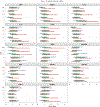Neonatal inflammation and its association with asthma and obesity in late childhood among individuals born extremely preterm
- PMID: 38914762
- PMCID: PMC12435514
- DOI: 10.1038/s41390-024-03325-x
Neonatal inflammation and its association with asthma and obesity in late childhood among individuals born extremely preterm
Abstract
Background: Asthma and obesity are frequent outcomes among individuals born extremely preterm and are associated with decreased lifespan. Neonatal inflammation is associated with chronic neurodevelopmental disorders; however, it is less studied in association with other later childhood chronic disorders in this population.
Methods: Fourteen hospitals in 5 U.S. states enrolled 1506 infants born before 28 weeks of gestation in the Extremely Low Gestational Age Newborn cohort in 2004-2014. Neonatal blood spots were collected on postnatal days 1, 7, 14, 21, and 28, and used to measure 14 inflammation-related proteins. Associations were evaluated between high (top quartile) levels of proteins and two chronic health disorders at ages 10 and 15 years: physician-diagnosed asthma and obesity (body mass index ≥95th percentile).
Results: Few associations were found between high levels of 14 inflammation-related proteins, either on a single day or on multiple days, and either asthma or obesity. Similarly, few associations were found in analyses stratified by sex or presence/absence of prenatal inflammation.
Conclusions: In extremely preterm newborns, systemic elevations of inflammation-related proteins during the neonatal period were not associated with childhood asthma and obesity outcomes at 10 or 15 years of age.
Impact: In the large multi-center Extremely Low Gestational Age Newborn (ELGAN) cohort, sustained elevation of neonatal levels of inflammation-related proteins was not consistently associated with asthma or obesity outcomes at 10 or 15 years of age. This finding contrasts with reported associations of perinatal inflammation with obesity at 2 years and neurodevelopmental disorders at 2-15 years in the ELGANs, suggesting that unlike neurodevelopment, peripubertal obesity and asthma may be driven by later childhood exposures. Future research on perinatal mechanisms of childhood asthma and obesity should account for both fetal and later exposures and pathways in addition to inflammation at birth.
© 2024. The Author(s), under exclusive licence to the International Pediatric Research Foundation, Inc.
Conflict of interest statement
Competing interests: The authors declare no competing interests. Content to participate: For collection of obstetrical and neonatal data for study participants, mothers provided signed informed consent. For collection of outcome data at 10 and 15 years, a parent or legal guardian provided signed informed consent and children provided assent. Consent and assent procedures were approved by institutional review board at each of 14 enrollment sites (maternal and neonatal data) and 12 follow up sites (10 and 15 year data).
Figures


References
Publication types
MeSH terms
Grants and funding
LinkOut - more resources
Full Text Sources
Medical

